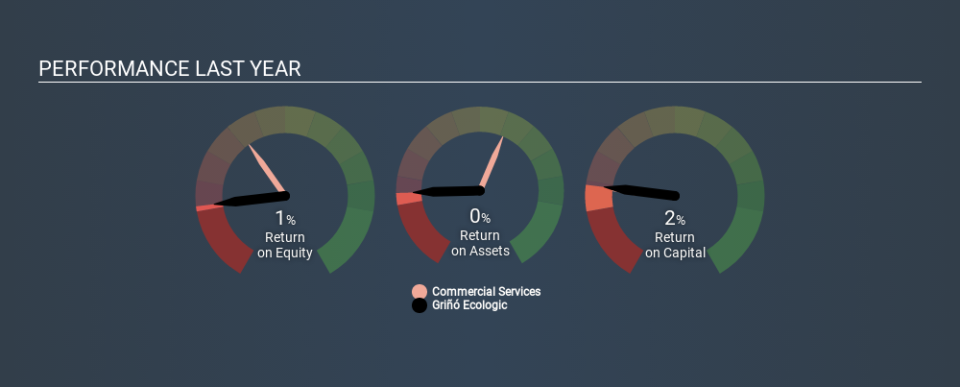Why Griñó Ecologic, S.A.’s (BME:GRI) Return On Capital Employed Looks Uninspiring

Today we'll look at Griñó Ecologic, S.A. (BME:GRI) and reflect on its potential as an investment. Specifically, we're going to calculate its Return On Capital Employed (ROCE), in the hopes of getting some insight into the business.
First up, we'll look at what ROCE is and how we calculate it. Next, we'll compare it to others in its industry. Last but not least, we'll look at what impact its current liabilities have on its ROCE.
Understanding Return On Capital Employed (ROCE)
ROCE is a metric for evaluating how much pre-tax income (in percentage terms) a company earns on the capital invested in its business. All else being equal, a better business will have a higher ROCE. Overall, it is a valuable metric that has its flaws. Author Edwin Whiting says to be careful when comparing the ROCE of different businesses, since 'No two businesses are exactly alike.
So, How Do We Calculate ROCE?
Analysts use this formula to calculate return on capital employed:
Return on Capital Employed = Earnings Before Interest and Tax (EBIT) ÷ (Total Assets - Current Liabilities)
Or for Griñó Ecologic:
0.021 = €737k ÷ (€54m - €18m) (Based on the trailing twelve months to December 2018.)
So, Griñó Ecologic has an ROCE of 2.1%.
Check out our latest analysis for Griñó Ecologic
Does Griñó Ecologic Have A Good ROCE?
One way to assess ROCE is to compare similar companies. We can see Griñó Ecologic's ROCE is meaningfully below the Commercial Services industry average of 11%. This performance could be negative if sustained, as it suggests the business may underperform its industry. Independently of how Griñó Ecologic compares to its industry, its ROCE in absolute terms is low; especially compared to the ~0.4% available in government bonds. It is likely that there are more attractive prospects out there.
You can see in the image below how Griñó Ecologic's ROCE compares to its industry. Click to see more on past growth.
Remember that this metric is backwards looking - it shows what has happened in the past, and does not accurately predict the future. Companies in cyclical industries can be difficult to understand using ROCE, as returns typically look high during boom times, and low during busts. ROCE is only a point-in-time measure. How cyclical is Griñó Ecologic? You can see for yourself by looking at this free graph of past earnings, revenue and cash flow.
Do Griñó Ecologic's Current Liabilities Skew Its ROCE?
Short term (or current) liabilities, are things like supplier invoices, overdrafts, or tax bills that need to be paid within 12 months. The ROCE equation subtracts current liabilities from capital employed, so a company with a lot of current liabilities appears to have less capital employed, and a higher ROCE than otherwise. To check the impact of this, we calculate if a company has high current liabilities relative to its total assets.
Griñó Ecologic has current liabilities of €18m and total assets of €54m. As a result, its current liabilities are equal to approximately 34% of its total assets. With a medium level of current liabilities boosting the ROCE a little, Griñó Ecologic's low ROCE is unappealing.
What We Can Learn From Griñó Ecologic's ROCE
This company may not be the most attractive investment prospect. Of course, you might also be able to find a better stock than Griñó Ecologic. So you may wish to see this free collection of other companies that have grown earnings strongly.
If you like to buy stocks alongside management, then you might just love this free list of companies. (Hint: insiders have been buying them).
If you spot an error that warrants correction, please contact the editor at editorial-team@simplywallst.com. This article by Simply Wall St is general in nature. It does not constitute a recommendation to buy or sell any stock, and does not take account of your objectives, or your financial situation. Simply Wall St has no position in the stocks mentioned.
We aim to bring you long-term focused research analysis driven by fundamental data. Note that our analysis may not factor in the latest price-sensitive company announcements or qualitative material. Thank you for reading.


